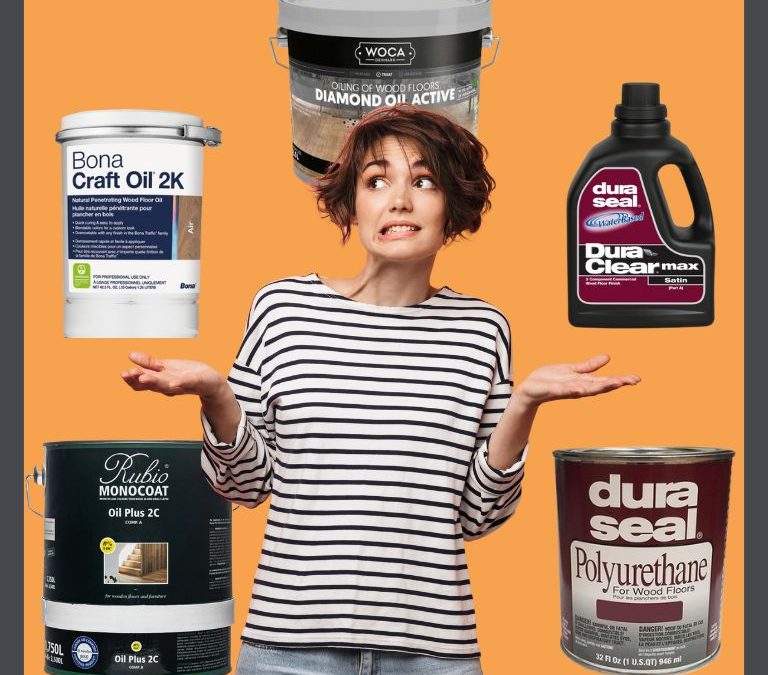
by bungalow101 | Jul 30, 2022 | Wood floors
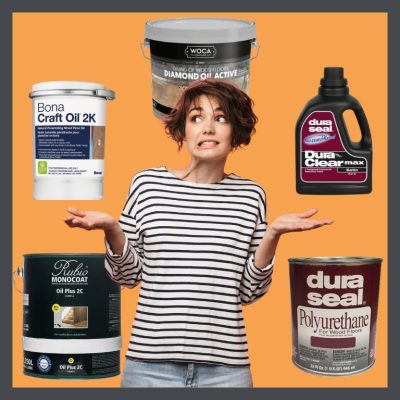 The finish is the material that goes on top of a prepared wood floor- a correctly & thoroughly prepared floor- that makes it look fresh, emphasizes the grain & protects the wood, a comparatively soft & porous material.
The finish is the material that goes on top of a prepared wood floor- a correctly & thoroughly prepared floor- that makes it look fresh, emphasizes the grain & protects the wood, a comparatively soft & porous material.
This finish does not protect the wood from denting, from standing water or pet accidents, subfloor moisture issues, from dragging heavy furniture across it, or doggy toenails. Abrasion resistance/durability is about how long will it take to wear through it with normal traffic. Take a look at my article on cleaning & maintaining your polyurethane coated wood floors
There are many products on the market, & I think the best way to choose the right wood floor finish for your bungalow, is to examine some of these products & consider their pluses & their minuses. I am not going to talk about stains (changing the color of the wood) here. Historically, wood floors were not stained. They were left natural & have aged & darkened to a beautiful patina over the decades. So that’s what I am going to recommend- floors au naturel.
As with any material that you use, or is used by a hired professional, I suggest that you read the manufacturer’s data, the Safety Date Sheet for the product & if you have any questions after reading the material, call the tech people at the manufacturer. They are the ones that most likely to have all the true & correct information about the product- not the pro, not the distributor or seller, not little ol’ me, but the manufacturer. I once had a really good painter apply paint in a method that was different from the manufacturer’s directions. The paint failed. The company’s literature said it would.
HIRE TRAINED WOOD FLOORING CRAFTSMEN WHO KNOW HOW TO CHOOSE THE RIGHT WOOD FLOOR FINISH
I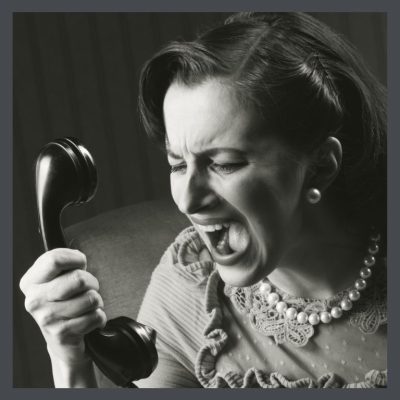 do not like speaking ill of members of my trade, but I have seen some pretty angry homeowners complaining about the odd choices made, resulting in high-gloss floors that gleamed like beacons in the night, floors that peeled before they were even dry & floors with their beautiful grain obscured by too many coats applied by the overzealous finisher.
do not like speaking ill of members of my trade, but I have seen some pretty angry homeowners complaining about the odd choices made, resulting in high-gloss floors that gleamed like beacons in the night, floors that peeled before they were even dry & floors with their beautiful grain obscured by too many coats applied by the overzealous finisher.
As a wood flooring professional, my focus, when I choose the right wood floor finish for your bungalow or decide on which technique or equipment to use, it to view their consistent workability & durability. After answering calls from tearful owners of old houses, seeing hundreds of attempts by others to do oddball stuff to save time &/or money, all the advice that I am giving you is based on my 40+ years of experience with professional products & techniques.
You have only so much wood layer left above the tongue & groove of your historic floor. Incorrect choices, over-aggressive or poor sanding can reduce your floor’s life by decades. I always recommend that any wood flooring tradespeople you hire be trained & certified by the companies that make wood floor finishes for your historic bungalow that they will actually use on your project. (Hopefully, they follow schooling that they learned!) The National Wood flooring Association has extensive training programs for installers, sander/finishers & even sales reps. Additionally, Bona, a finish company whose products we used for many years, has a topnotch training program for finishers. They train craftspeople in the use of their products, their state-of-the-art equipment & techniques, including removing the least amount of precious floor necessary to get the heavy marks out of it & create a surface with which the finish will tightly bond. I also recommend that you read my 7 VITAL Things to Know Before You Hire a Contractor.
I caution you against hiring someone to apply a particular type or even brand of finish for the very first time. The techniques & tools for applying each of these finishes varies hugely. They do not use the same skill set.
SO-O-O-O, WHAT’S THE RIGHT ONE?
My pros & cons are based on the use of these products in an old house- either for the installation of new or reclaimed/salvaged, wood or for the refinishing of existing wood. Folks seem to have strong opinions about wood floor finishes. Please be polite in expressing these opinions. Everyone has different requirements for their floors based on budget, lifestyle, skill level & aesthetic preferences. And perhaps the phases of the moon.
OIL-BASE POLYURETHANE FLOOR FINISHES
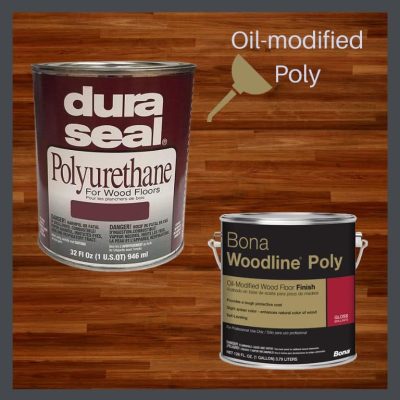 Pros: Approximates the illusion of depth that old finishes- shellac, wax, & varnishes showed & it ambers over time, again mimicking those historic materials. Costs less than many other types of finishes.
Pros: Approximates the illusion of depth that old finishes- shellac, wax, & varnishes showed & it ambers over time, again mimicking those historic materials. Costs less than many other types of finishes.
If you follow my maintenance guide & don’t have any water intrusion horrors, you have a good chance of never having to refinish your floor again by periodically recoating it. Check out the section RECOATING to learn more about this useful option.
Cons: Strong odor that can linger for months. Long cure time. More environmentally harmful. Flammable, as are applicator rags. Some people don’t like the fact that it ambers over time.
Sheens: Available in matte to high gloss. (With matte, it is almost impossible to get an even sheen.)
Recommended brands: Bona & Dura Seal (Not available at big box stores.
WATER-BASED FINISHES
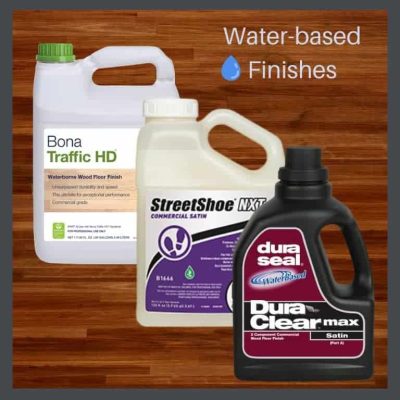 Pros: Easy application & cleanup; low odor and low VOCs; several gloss options, including an easy-to-use matte; no yellowing over time. Good scuff, scratch and chemical resistance at full cure. Quick drying. Easy care.
Pros: Easy application & cleanup; low odor and low VOCs; several gloss options, including an easy-to-use matte; no yellowing over time. Good scuff, scratch and chemical resistance at full cure. Quick drying. Easy care.
The ones we liked best were two-partwater-based finishes, such as Bona Traffic HD, Dura Clear Max, & Basic Coating Street Shoe which are considerably more durable than most oil-based polyurethanes. They have much better abrasion resistance and will last longer when used on your bungalow’s wood floors. However, water-based finishes sold at the retail level are not two-part & are less durable than these better, professional grade water-based finishes.
Cons: Raises grain when applied for the first couple of coats when no stain coat has been applied. Grain raise makes the wood surface feel rough, both in appearance & to the touch. A trained wood flooring professional should be able to deal with grain raise & would probably suggest a minimum of 3 coats, lightly abrading between each one.
Lower sheen or matte water-based finishes make the wood look bare rather than creating a look of depth that old finishes impart. Semi-gloss or gloss water-based finishes do give good depth of finish.
Sheens: Available in matte to high gloss, except for Bona Traffic HD which is not made in high gloss.
COMBINING FLOOR FINISHES
Another good option when you choose the right wood floor finish for your bungalow, is to consider applying 1-2 coats of Bona Dri-Fast oil poly sealer, with 2 coats of water-based Bona Traffic HD (stands for Hard & Durable!) on top. This combination gives you depth, ambering & durability plus avoids grain raise.
One thing that you must consider when combining an oil-based undercoat with a water-based overcoat, is that that the manufacturer states that they must be compatible. The most common situation is that most oil-based finishes require a 30 day minimum cure time before they should coated with the water-based finish, otherwise the top coat of water, could not adhere & it might peal. Here’s what Bona says about it, “Bona DriFast® Sealer is a quick drying, oil-modified polyurethane sanding sealer that’s designed to penetrate and seal bare wood. It is compatible with all Bona stains, oil-modified and waterborne finishes.”
Recommended brands: Bona, Basic Coatings, & Dura Seal. These products are available in extra durable product levels. (Not available at big box stores.)
Once again, if you follow my maintenance guide & don’t have any water intrusion events of magnitude, you can avoid refinishing your floor again by periodically recoating it.
OIL PENETRATING WOOD FLOOR FINISHES
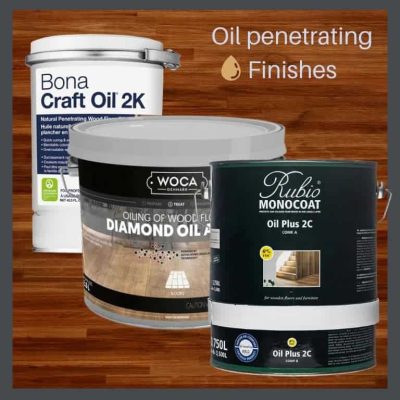 While other finish systems sit on top of the surface of the wood, oil penetrating wood finishes go down into the fibers of the wood, then harden on the surface.
While other finish systems sit on top of the surface of the wood, oil penetrating wood finishes go down into the fibers of the wood, then harden on the surface.
Pros: Offers a natural look because you do not look through it. Many contain no VOC’s. Easy application of non-pigmented products. We have found Rubio to have a moderate odor & WOCA’s to be stronger.
The use of these products requires periodic maintenance- re-applying oil, but may not ever need a full sand and refinish. If severely worn, a light sanding may be needed first.
Cons: The look is very matte & most people are accustomed to a bit of shine. It is a durable finish, however, we once used this coating on the floor of a studio of a painter. He worked in oils & his paint drips were not repelled by the finish but soaked right into the wood. It was awful!!!!
Pigmented oils require impeccable prep/sanding & are difficult to apply.
Clean-up is similar to that of oil-base finishes. You will need paint thinner to clean your hands, your brush or non-disposable applicators. All are flammable.
Recommended brands: WOCA, Rubio & Bona
TUNG & LINSEED OILS
In 40+ years in the trade, we did not have good luck with these materials for various reasons- cost, durability, toxicity, flammability, sheen choices, ease of use & ability to get a consistently good finish. There are no manufacturer recommendations for use on floors for some products. Floors lead a hard life & using a product designed to be applied to furniture is only going to lead to more maintenance. We greatly preferred the products mentioned above. If you should choose to use these product formulated with these oils, please ensure that they are specified for floors.
One more bit of advice- when it’s time to choose the right wood floor finish for your bungalow, no matter what the species, stay away from high-gloss sheens. They reflect so much light that you will not be able to see the beautiful wood grain. Additionally, they show even the tiniest scratches as well as dust & dirt. And the there’s the hairballs. Kitty’s urp is very high acid & will dull that mirror shine of high-gloss very quickly.
A QUICK WORD ABOUT FACTORY APPLIED FINISHES
This article also does not cover the types of finishes available for prefinished products. There are prefinished products that you can choose with finishes that are actually tougher than the types of finishes mentioned above, which are applied in your home.
These finishes are applied by machine to flooring at the factory & are exceptionally hard & durable. When these finishes are applied during the manufacturing process, the application is done in a highly controlled setting — as opposed to the conditions on a job site. The contractor can not create the same conditions found in a mill because of the equipment required & also safety concerns. Some companies offer a urethane/ceramic finish which is UV-cured to increase hardness. Others offer finishes with aluminum oxide particles added to increase the abrasion resistance of the wear layer.
Prefinished products have pluses & minuses which are explained here.
THE MANUFACTURER HAS THE MOST INFORMATION ABOUT THEIR WOOD FLOOR FINISH PRODUCT
As always, whether you are hiring someone to perform the work or doing it yourself, study the manufacturer’s materials (printed & online) & contact the manufacturer with any & all questions that you might have. They have tech people who thoroughly know the product & are glad to help you. Caveat: Some of them are more knowledgeable than others. Should you speak with a representative who doesn’t sound confident or doesn’t answer your questions so that you are confident, ask for someone with more experience. Always request where each piece of information can be found in their literature or online so that you can refer back to it. Be prepared to take notes.
Yes, your flooring craftsman has information. Yes, the distributor has information, but the people who really know are the customer service rep’s at the company & when they don’t know, I get transferred to the tech people there. Do not be afraid to insist on getting the information you need to fully understand the product.
For each product, study the Safety Data Sheets & protect yourself & your family from chemicals & toxins in your home. And enjoy your beautiful wood floors!
 STAY IN THE BUNGALOW KNOW!!!
STAY IN THE BUNGALOW KNOW!!!
Sign up for our newsletter & receive our FREE E-book, 7 VITAL Things to Do Before You Hire a Contractor.
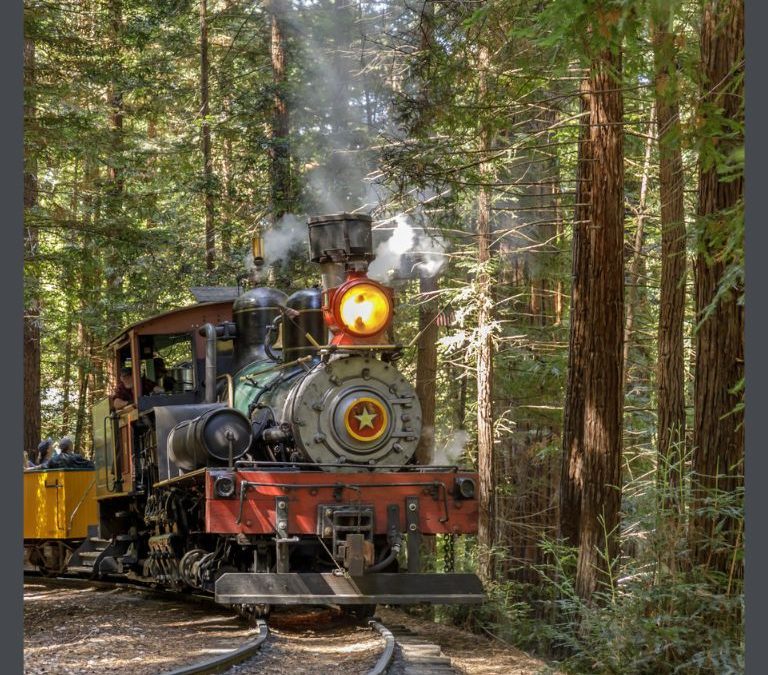
by bungalow101 | Jul 24, 2022 | Wood floors
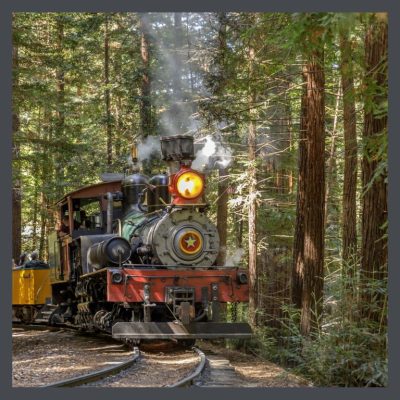 I consider historic bungalow wood floors to be the single most endangered historic fabric, well, maybe second to windows! As a tree-hugging, wood flooring professional, specializing in the restoration & preservation of historic floors, I’d like to pass on what I have learned in over 40 years in the trade. I’m starting here with HISTORIC BUNGALOW WOOD FLOORS 101- From the Forest to Your Floor, so that you will understand the value of your original wood flooring material that was gifted to us by the forest primeval.
I consider historic bungalow wood floors to be the single most endangered historic fabric, well, maybe second to windows! As a tree-hugging, wood flooring professional, specializing in the restoration & preservation of historic floors, I’d like to pass on what I have learned in over 40 years in the trade. I’m starting here with HISTORIC BUNGALOW WOOD FLOORS 101- From the Forest to Your Floor, so that you will understand the value of your original wood flooring material that was gifted to us by the forest primeval.
“They’re not shiny enough.” “They’re the wrong color.” “I just bought my house & I want everything to be fresh & new.”
The value of this valuable material is often not understood & the poor floors often get attacked by a sanding machine at the hands of a person who doesn’t have a learner’s permit let alone a license to drive such a machine. (That’s a joke but there is training for the most conscientious craftsmen which saves floors & honors trees.) You can read about our viewpoint on when to sand here.
Let’s see what precious material, harvested over a century ago from the old-growth forests of our country, this wood actually is, that we may decide to treat it more gently.
A GIFT FROM THE FOREST TO YOUR BUNGALOW
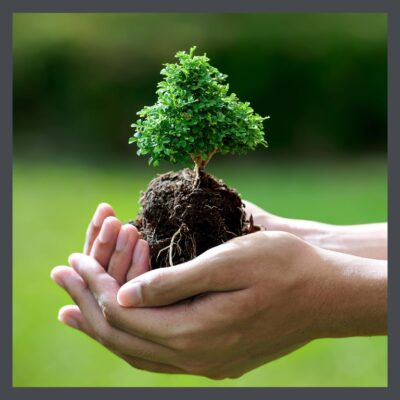 Your historic bungalow’s wood floor began as trees. It is a product of Mother Nature, gifted by her warmth & beauty, but also subject to her whims. Consequently, to fully understand & properly care for your floor, it helps to know a bit about your floor’s life from its conception.
Your historic bungalow’s wood floor began as trees. It is a product of Mother Nature, gifted by her warmth & beauty, but also subject to her whims. Consequently, to fully understand & properly care for your floor, it helps to know a bit about your floor’s life from its conception.
The seed holds all the parts of the tree as well as the nutrients it needs to get started. Given the proper conditions, soil, water, temperature, it sprouts into a tiny seeding. After only a few weeks you will see a miniature tree, complete with leaves, needles, bark & wood.
Like everything else on earth, ancient trees sprang from the sea & like all other life, are dependent on water. The entire tree has evolved to move water to all its parts.
When we look at a historic bungalow wood floor, we see the tree’s trunk & branches. The trunk’s function is to support the tree’s limbs & to move water & nutrients from the roots to the leaves. As the tree grows taller & taller in its reach for the sun, allowing its leaves to photosynthesiz to make food for the tree, it expands in girth to increase its ability to support its increasing height. Each year the cambium (See the diagram below.) adds new layers of woody tissue which create the tree’s annual rings which you are very visible.
HISTORIC BUNGALOW WOOD FLOORS 101- ANATOMY OF A TREE
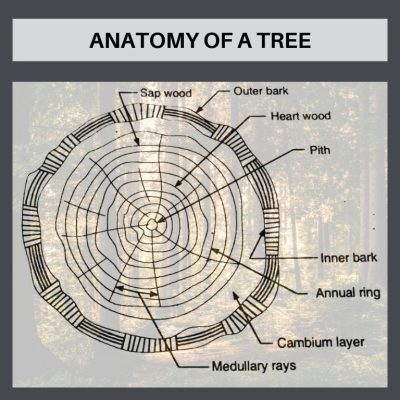 The bark covers the tree to protect it from pests & disease. Just under the bark is the layer called the cambium. It is made of growth tissue cells & these cells divide to increase the tree’s diameter.
The bark covers the tree to protect it from pests & disease. Just under the bark is the layer called the cambium. It is made of growth tissue cells & these cells divide to increase the tree’s diameter.
The sap wood, on the outer edges of the tree is made up of the youngest layers of wood. Its cells carry moisture & nutrients- sugars, amino acids, vitamins, hormones, minerals & micro-nutrients from the tree’s roots to its leaves.
In an old tree which has lived many centuries, like the ones from which the lumber was cut to produce our bungalows, most of the trunk is dead. This wood, on the inside of the tree, is called heart wood. It has ceased transporting nourishment for the tree, & has become a repository for various chemical compounds. The heartwood is often much darker in color than the sapwood. The heartwood gives the tree support, but in some species, as the tree grows, it rots away leaving a hollow, living tree.
Heartwood tends to be more durable than sapwood. It is less subject to attack by certain insects & by stain & mold-producing fungi. This wood at the center of the tree, is usually more highly colored & therefore considered more ornamental. It is more highly prized for historic bungalow wood floors, than the white sapwood. Heartwood is also less permeable to liquid, containing more resin than the sapwood.
The meduliary rings are ribbons of cells running from the inside of the plant to the outside which carry nutrients & chemicals which fight invasion by insects & fungi, & block any damaged areas, out toward the surface of the tree. The pitch is found in the middle of the stems & roots of many plants which store & transports nutrients. It is the oldest part of the tree.
HISTORIC BUNGALOW WOOD FLOORS 101- Honoring the Miracle of the Forest
The intrepid men who logged our wood from the forest are long gone, but here’s a shout-out to their efforts in ensuring that we have our cozy little bungalows to live in for the next 100+ years. There’s a very cool group who graciously allowed me to use their photo. Click on over to read the fascinating history of logging here.
I ask you to remember the miracle of the forest. Honor those men & those trees by preserving your floors.
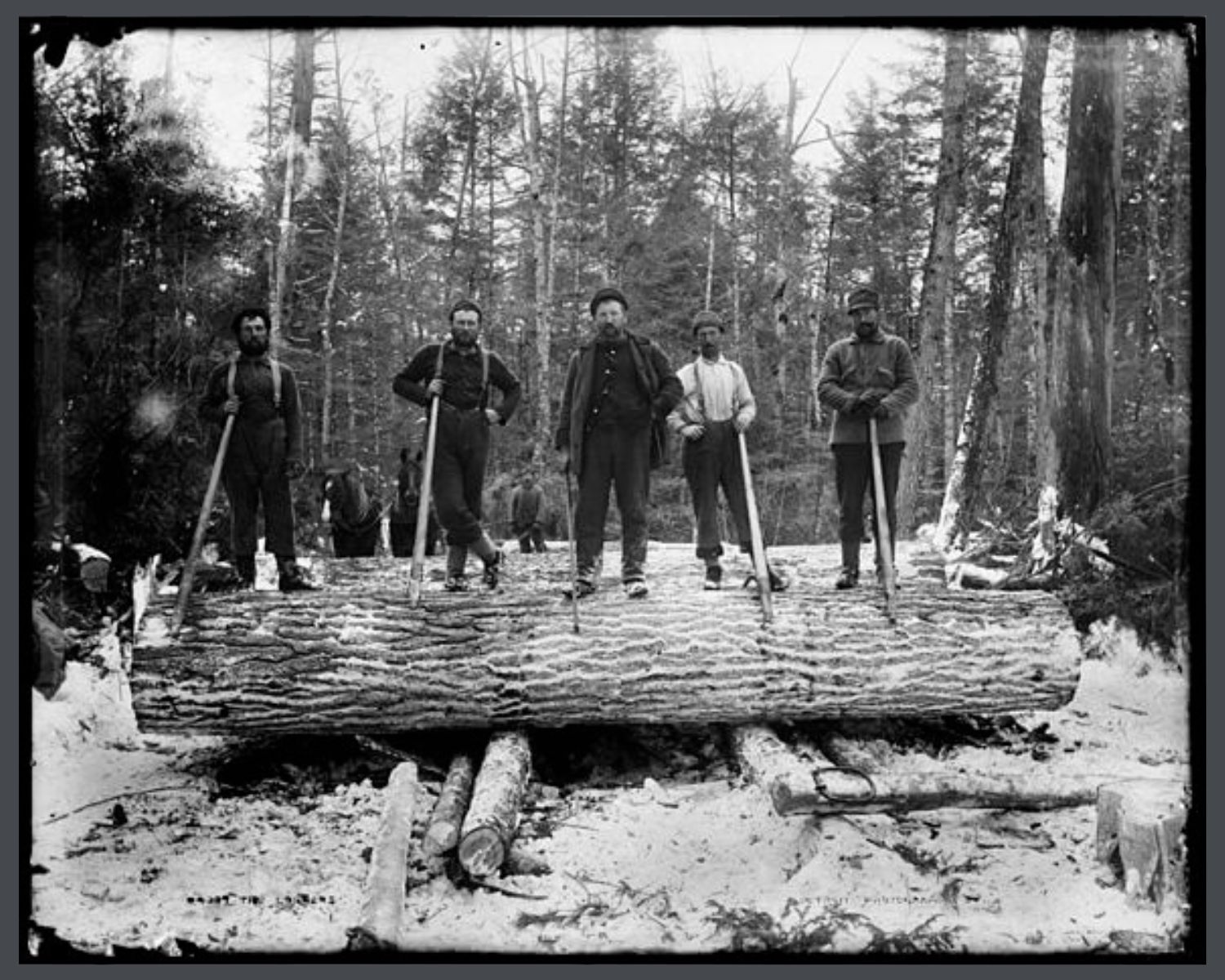
TIP: If you love wood floors, there’s plenty to learn about them here!

STAY IN THE BUNGALOW KNOW!!!
Sign up for our newsletter & receive our FREE E-book, 7 VITAL Things to Do Before You Hire a Contractor.
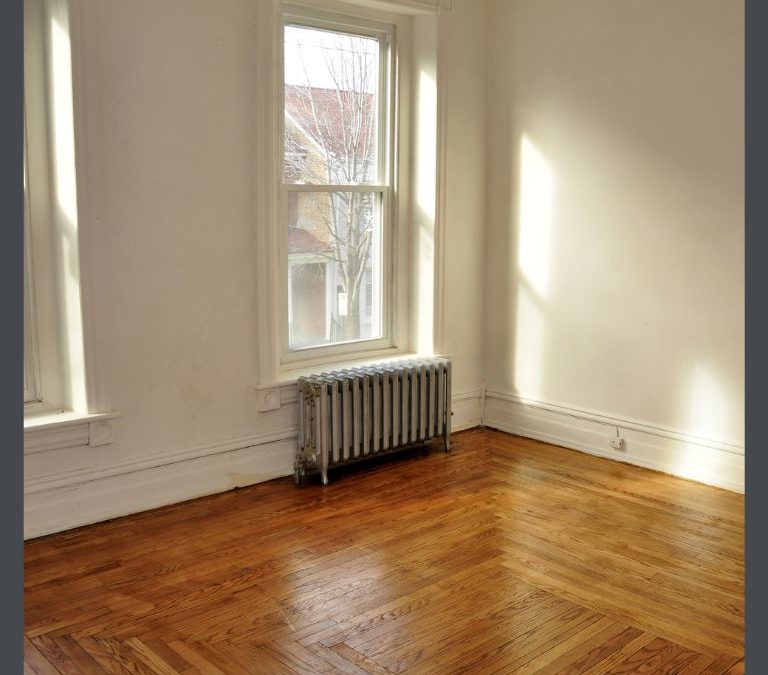
by bungalow101 | Jul 23, 2022 | Wood floors
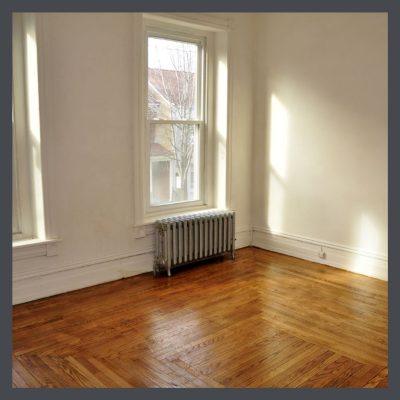 There are several species of wood flooring most commonly found in historic bungalows. I have seen others but the species below are the ones to consider first when you do not know what your floor is.
There are several species of wood flooring most commonly found in historic bungalows. I have seen others but the species below are the ones to consider first when you do not know what your floor is.
It is important to know the species of your bungalow wood floor because different species have different properties & should be treated differently. For example, Maple is difficult to stain while Oak takes stain readily. This article takes a look at these characteristics so that you can determine the species of wood in your house & better know how to restore your floors.
With regard to pictured below of the species of wood flooring found in historic bungalows, realize that the old growth wood that you find in your home, is often harder & darker than newly harvested wood which is what is pictured here. The hardness of the species listed below pertains to newly harvested, mostly farmed wood. And, different finishes change color differently over time, so you can get an idea of your species from the color of the images, but also you’ll need to study the grain patterns.
When I’m referring to staining properties & I state, …”stain & finish application extremely well when the proper techniques are used,” my meaning is that it’s difficult to apply stain color without a great deal of practice, following the manufacturer’s directions to the letter with regard to material preparation, temperature, material & condition of applicator, etc. You can read about different types of finishes here.
I am listing these species by order of popularity, i.e., how often I have seen them used in houses built from 1900-1930.
And, don’t forget to use the GLOSSARY!
THE HARDWOOD SPECIES FOUND IN BUNGALOWS
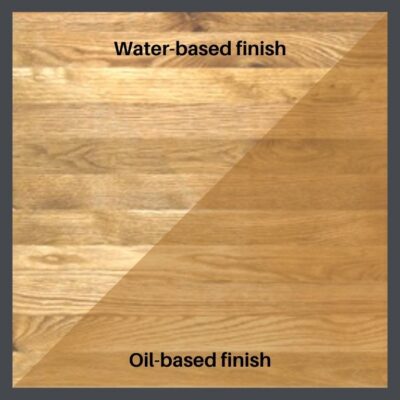 White Oak (Quercus alba)
White Oak (Quercus alba)
This is the species of wood flooring most commonly found in historic bungalows in almost all parts of the country.
Color: White Oak’s heartwood is light brown; some boards may have a pinkish tint or a slight grayish cast. Its sapwood is white to cream. In this species you can see considerable variation among boards in both color & grain texture.
Grain: Open. There are several ways to cut the wood from the log, each resulting in a different grain pattern. Most old floors will have combination of grains. A closed grain wood, White Oak tends to be more resistant to water damage than is Red.
Janka Hardness: 1360
Staining & finishing: White Oak’s takes stain & finish application extremely well when the proper techniques are used. It is usually left natural in older houses which displays the grain most beautifully as well as the contrast with other species that might have been used.
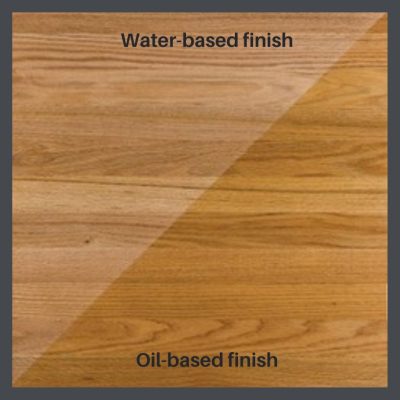 Red Oak (Quercus rubra)
Red Oak (Quercus rubra)
White Oak was used in floors until the 1940’s at which time Red Oak predominated, so your original bungalow floor is unlikely to be Red Oak. However, we have often seen White Oak floors replaced with Red, later additions with Red & we have seen many instances of floors having been patched with the wrong Oak, even by “professionals.”
Color: Red Oak’s heartwood is a light to medium brown, commonly with a reddish cast. Paler sapwood is not always sharply demarcated from the heartwood. White oak tends to have a slightly more olive cast than that of Red, but color alone isn’t always a reliable method of determining the type of oak.
Grain: Grain is straight, with a coarse, uneven texture & large pores. As an open grain wood, Red Oak tends to be less resistant to water damage than White.
Janka Hardness: 1,290
Staining & finishing: Stains easily is but usually left natural in older houses.
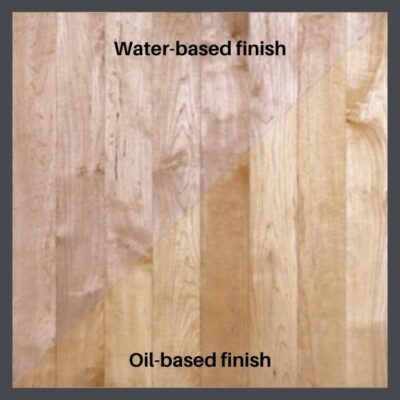 Maple (Acer saccharum)
Maple (Acer saccharum)
Color: Heartwood is creamy white to light reddish brown; sapwood is pale to creamy white. Unlike most other hardwoods, the sapwood of hard maple lumber is most commonly used rather than its heartwood. Over time, even the lighter wood it can darken to brown.
Grain: Closed, subdued grain, with medium figuring and uniform texture. Occasionally shows bird’s-eye figuring. Because of its delicate garining, Maple floors are on the formal side.
Stability: Although Maple is a very hard wood, it does not have great stability, meaning that compared to other woods, it can absorb water more easily & warp.
Janka Hardness: 1,450
Staining & finishing: Very difficult to stain. Old Maple floors were never stained. They were always clear coated. I would recommend that if you like the light color of Maple, that you apply a water-based finish rather than oil. The water does not change color over time while the oil finish ambers.
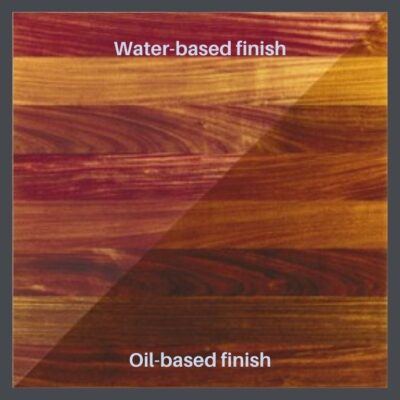 Mahogany (Swietenia macrophylla)
Mahogany (Swietenia macrophylla)
Color: Heartwood color can vary a fair amount, from a pale pinkish brown to a darker reddish brown, tending to darken with age. It has an amazing & beautiful 3D look that changes as you look at the wood from different angles.
Grain: Mahogany’s grain can be straight, interlocked, irregular or wavy. It’s tecture is medium & uniform, with moderate natural luster.
Staining & finishing: Stains easily but why would you want to? For centuries fine furniture makers have used it to make grand pieces & also as an accent wood. They did not stain it, but just allowed to glorious color to display.
We saw Mahogany in some of the larger, more upscale bungalows in Los Angeles. This makes sense because an imported wood must be transported from a great distance which adds to the cost. We saw none in Florida.
THE SOFT WOOD SPECIES OF FLOORING MOST COMMONLY FOUND IN HISTORIC BUNGALOWS
These two species below look very similar in color & grain. The best way to differentiate them is by the area of the country in which they are used- Doug Fir in the West & Heart Pine in the East. Both were regarded as more common in these areas to which they were indigenous, & often used in private areas, while the mosre expensive hardwoods were used in the public spaces.
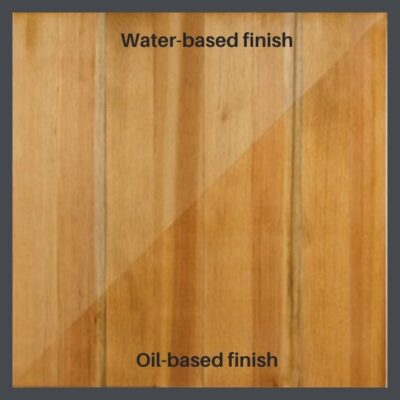 Douglas Fir (Pseudotsuga menziesii)
Douglas Fir (Pseudotsuga menziesii)
Color: Freshly cut Doug Fir’s heartwood is yellowish tan to light brown, while the sapwood is tan to white. Heartwood may be confused with that of Southern Yellow Pine. You can expect radical color change -getting darker & redder- upon exposure to sunlight. When you sand a Fir floor, the floor will become lightener because you are removing the oxidized layer. It will darken again for a period of decades. The sample on the left is more like what you would see after sanding than what you’re likely to see on your home.
Grain: Normally straight, with occasional wavy or spiral texture.
Janka Hardness: 660
Staining & finishing: Takes stain & finish application well when the proper techniques are used, but not as easily as Oak. It will patina to a beautiful rich color. I don’t recommend staining it.
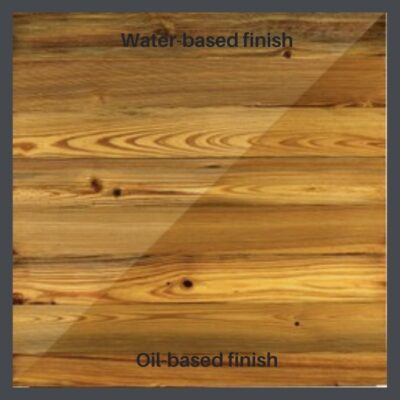 Heart Pine (Pinus palustris)
Heart Pine (Pinus palustris)
Color: Heartwood is yellow after cutting & turns deep pinkish tan to warm reddish brown quickly due to high resin content. Sapwood remains yellow, with occasional blue-black sap stain.
Pine & Fir look very similar to each other each other but Pine is more common in the East & Fir in the West.
Grain: Dense, with high figuring.
Janka Hardness: 1225
Staining & finishing: Takes stain & finish application well when the proper techniques are used, but not as easily as Oak. But please don’t stain your Heart Pine floor. It has spent 100 years developing its beautiful, rich color & even if you sand it, it will turn color again.
TIP: READ A GREAT ARTICLE ABOUT THIS WONDERFUL MATERIAL BY CAROL GOODWIN OF GOODWIN HEART PINE HERE.
 STAY IN THE BUNGALOW KNOW!!!
STAY IN THE BUNGALOW KNOW!!!
Sign up for our newsletter & receive our FREE E-book, 7 VITAL Things to Do Before You Hire a Contractor.
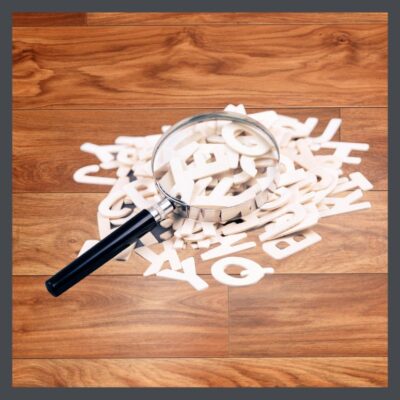
by bungalow101 | Jul 22, 2022 | Wood floors
 Use this bungalow wood floors restoration glossary when you’re ready to have the wood floors of your bungalow refinished or when you need some installed. After having dealt with myriad contractors, you have learned a great deal about each trade & realize that the next time you restore a bungalow, it will be a dang sight easier!
Use this bungalow wood floors restoration glossary when you’re ready to have the wood floors of your bungalow refinished or when you need some installed. After having dealt with myriad contractors, you have learned a great deal about each trade & realize that the next time you restore a bungalow, it will be a dang sight easier!
My purpose is to educate you sufficiently so that you will know more about this particular phase going in, instead of after it’s done & you’re wondering why it’s not exactly like you wanted it to be. I can’t make you an expert, but I can impart enough information in this wood flooring glossary so that you will understand the process before it begins, giving you better control over the final product. It starts with knowing the terminology.
So, when you get your wood floor refinishing proposal, make a nice cuppa ginger tea (hot or cold) & really read it. You also might want to get my 7 Vital teps to Hiring a Contractor e-book that you can get for FREE by just signing up for my mailing list.
I’m also thinking reading my hubby’s article on refinishing would be good too.
Let’s make it easier this time! And if you run across words in the any that I have missed, let me know & I’ll add them to the bungalow wood floor restoration glossary. I spent 45 years of my life educating people about historic wood floors so I want to get it right!
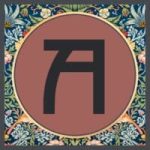
Acclimation
Allowing wood to adjust to the humidity in your home before installing & then again before sanding. This is important because wood expands & contracts based on the amount of moisture in the air.
Ambering
A red/yellowish color change in a floor from certain finishes. Your existing floor has ambered over the years. When your floor gets sanded, it will be a much lighter color.

Baseboard
A molding designed to be attached to the wall to cover the edge of a floor.
Blind nailing
Nailing at a 45 degree angle into the tongue so that the nail is not seen on the top of the floor.
Borders
Simple or intricate designs which frame & customize a flooring installation.
Buckling
Extreme warping of a wood floor from moisture, where some of the boards are actually lifting up off of the subfloor.
Burl
A rounded woody swelling on a tree trunk. The grain of the wood milled from such a knot is patterned & unusual.

Chatter marks
Patterned markings left on a floor by improper handling of a drum sander.
Crowning
A convex or raised appearance of individual strips, with the center raised above the edges.
Cupping
A concave or dished appearance of individual strips, with the edges raised above the center. Cupping is always caused by a moisture imbalance and is often the sign of a water intrusion or wet crawl space issue.
Cure
There’s dry & there’s cured, which is when a finish has reached its fullest hardness potential. Different types of finishes dry & cure at different rates.

Dimensional stability
Wood is a natural product & reacts to changes in humidity and temperature-warping, expanding, shrinking. Different species of wood react & change in differing degrees.
Domestic woods
These woods are harvested from trees that are native to & grown in the United States.
Drum sander (AKA big machine)
A type of sander used to smooth the floor, using replaceable abrasive sandpaper sheets to the surface of wood flooring to prepare it for finishing & sometimes staining.
Dustless sanding
Today’s technology features machines that have an integrated dust collection system. Most companies promote 99% efficiency. Many of our former customers reported 100% satisfaction.

Edger
A powerful, large, orbital hand (It spins around & around, flat against a surface) sander that allows you to sand the edges of floors, right up to baseboards and walls.
Engineered flooring
A wood flooring product that is made of layers of wood pressed together, with the grains running in different directions. Do not
Exotic woods
Woods that are from trees native to, & grown in countries other than the U.S.
Expansion
Wood is a product of nature & is affected by changes in the environment. It expands when it is exposed to water or humidity.
Expansion spacing
A space is left at the baseboard to allow for the floor to expand, which occurs with moisture. The space is covered by the base shoe molding.

Filler
Material which fills cracks or nail holes in a floor. It is tinted the color of the floor.
Finish
Protective coating applied to a wood floor.

Gloss level (Also known as sheen level)
The amount of light reflected by a particular finish. Your choices are satin or matte, semi gloss and high gloss.
Grade
The appearance of wood is judged (graded) by the number of visible knots & other natural markings.

Hardness
Refers to the strength of the hardwood species, based on a scale which measures the amount of force it takes to drive a .444 inch steel ball into a plank of wood .222 inches.
Hardplate
Use of equipment that will give you the flattest floor. It will remove high spots, such as chatter marks, without taking out soft grain.
Hardwood
A botanical group of trees that has broad leaves as opposed to needles. The wood of these trees is normally harder than needle bearing trees. Common hardwoods found in bungalow floors are oak, maple, mahogany.
Heart pine
Wood from the center of old-growth long leaf pine that is darker, denser & somewhat harder that newly harvested wood. Heart pine is much valued amongst bungalow owners.
Heartwood
Slightly harder & darker, non-living wood at the center of a tree at its center.

Intercoat abrasion
You want to ensure that the finish will be well-bonded to the floor’s surface. In order to achieve this bond, each coat applied must be lightly abraded after it is completely dry- so dry that the finish will form a powder when it is abraded.

Job finished
Floors that are sanded, stained & finished in your home.
Joists
Framing members, often a 2″ x 8″ pieces of lumber, which are usually spaced every 16″ to 24″ & support the sub-floor & flooring. Joists usually ‘sit’ on a sill beam (the structural beam that lays on top of your piers) or, toward the center of your house, right on the piers. In older homes, the flooring is often laid directly over these joists, with no subfloor.
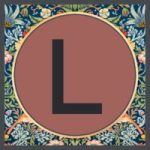
Lacing in
The practice of replacing boards that are discolored or damaged, while leaving the remaining floor. The new boards are of the same wood (ideally reclaimed) & same width as the exiting boards.

Mill
To cut wood into a desired shape, e.g., strip or plank flooring, etc.
Moisture meter
A special device for testing moisture content in wood floors. Moisture issues should be detected & addressed before sanding your floors.
Moldings
Pieces of wood milled to install in a floor, giving it a finished look.

Nosing
A hardwood molding used to cover the outside corner of a step.
NWFA
An acronym for the National Wood Flooring Association which sets the standards for, & provides education & training for the industry.
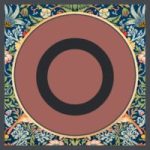
Old-growth wood
Lumber that has been cut from trees that grew in America before the settlers came. Some of these trees were hundreds of years old when they were harvested. This is the wood we treasure in our old houses.

Parquet
A wood tile composed of individual slats assembled together, forming a pattern.
Penetrating oil sealers
These oil-based sealers are spread across the floor, allowing them to penetrate the surface, offering a stain and a finish to protect it. Excess is removed with a sponge or cloth. They offer differing levels of protection.
Photo sensitivity
Refers to the likelihood a wood floor’s color will change as it is exposed to light. The existing floors in your bungalow have spent 100 years doing this!
Plank
Wood flooring boards 3” & wider designed to be installed in parallel rows. In random width plank, the boards vary in width from 3” to 8”.
In very old floors, these planks can be just boards, nailed side-by-side. Newer floors have a tongue pattern cut into 1 side & a groove on the other side.
Plain sawn
The usual way of cutting a log. It gives a random mix of grain patterns.
Polyurethane
Type of finish for hardwood that does not require waxing.
Prefinished
Factory-finished flooring that requires only installation.\n\n[/cs_content_seo][cs_element_text _id=”43″ ][cs_content_seo]Quarter Round
A type of trim used between vertical walls and the floor.

Quartersawn
Wood which has a grain that runs parallel to the length of the board. (It is sometimes called “vertical grain”.) In oak the boards have ray-like markings running diagonally across them.

Sapwood
Wood near the outside of a tree. It is usually lighter in color than heartwood.
Screen and Coat
(Also referred to as “Recoat”.) A light scuff sanding of the existing urethane finish, followed by application of a coat (or coats) of urethane.
Sealer
Any finishing material that seals the wood.
Shellac
A resin substance secreted by female lac bugs. Used to form a cocoon, the resin comes from India and Thailand. Processed as dry flakes, it can be added to denatured alcohol to create a liquid. This liquid is then used as a food glaze or floor finish. It’s a natural option which is highly resistant to stain and odor. It provides a high gloss finish.
Solid flooring
Made from boards which are single pieces of wood from top to bottom.
Splintering
Can occur at the side of the boards when a floor is at the end of its useful life, or otherwise damaged.
Staining
The act of changing the color of wood without disturbing the texture or markings, through the application of transparent, pigmented liquids.
Strip flooring
Solid or engineered boards, “1 & 1/2” – “2 & ¼” wide, installed in parallel rows.
Subfloor
A foundation for a floor in a building. It can be concrete, plywood, or in older homes, pine planking.

Tongue & groove
In strip, plank and parquet flooring, a tongue is cut on one edge & a groove cut on the opposite edge. As the flooring is installed, the tongue of each strip or unit is interlocked with the groove of the adjacent strip or unit.
Top nailing (face nailing)
The old plank floors were nailed from the top of the planks while tongue & groove floors are nailed into the grooves so that the nails are hidden.
Trim
The finish moldings, such as baseboards or base shoe.

Urethane
Most common finish for wood flooring, available in various gloss levels

Vapor retarder
A material, such as foil, plastic film or specially coated paper, with a high resistance to vapor movement, used to control condensation or prevent migration of moisture.
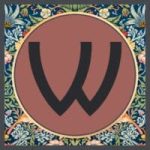
Wear layer
The sandable wood surface above the tongue and groove. On 3/4″ solid wood floors, the wear layer is typically 6 millimeters (0.23622 inch). This is why you want to take good care of your floors!
Hopefully this bungalow wood floors restoration glossary helps you make sense of what you are seeing in your flooring proposal. If you still have questions, feel free to send them them to me & if I can’t answer them, I can pretty much guarantee that my brilliant husband can.
 STAY IN THE BUNGALOW KNOW!!!
STAY IN THE BUNGALOW KNOW!!!
Sign up for our newsletter & receive our FREE E-book, 7 VITAL Things to Do Before You Hire a Contractor.
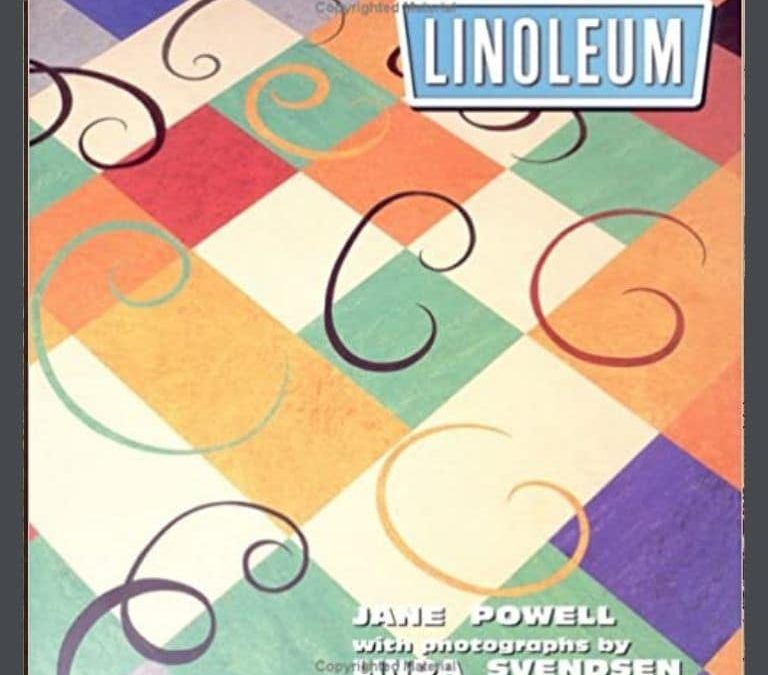
by bungalow101 | Jun 26, 2022 | Kitchens
by Jane Powell, author & Linda Svendsen, photographer
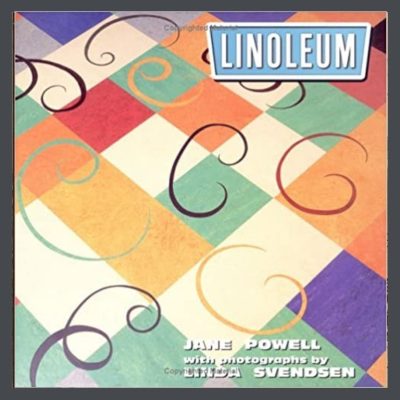 Many people consider LINOLEUM by Jane Powell to be their favorite book in the series. There are others who don’t get this beautiful, functional material & consider it to be a cheap, substandard product. Nope!
Many people consider LINOLEUM by Jane Powell to be their favorite book in the series. There are others who don’t get this beautiful, functional material & consider it to be a cheap, substandard product. Nope!
Just so’s you know, these are not images from the book & sadly, not images from my own kitchen, though you can see from this story that I really tried hard. They are ones that I have found in my own research & am including to whet your appetite for the real ones in the book which are WAY COOLER!!!!!!!!!!
Linoleum is not vinyl. Vinyl, flooring, manufactured since the 1980s (The decade alone should tell ya somethin’.) is composed of colored polyvinyl chloride (PVC) chips smushed into solid sheets by heat and pressure.
Lino, on the other hand, is made of all-natural materials- wood flour, rosins (made from pine trees & is used to make things stick together), ground limestone, powdered cork, pigments, jute and linseed oil. It is so green that you can recycle old lino to make new lino.
Admittedly, a great feature of vinyl flooring is that it can be made to mimic wood, stone, marble, brick & even linoleum! Why use the real deal when you can have the fake one?!?!? And it’s way cheaper!
A miracle of modern technology, most easy-care vinyl flooring, is made from toxic chemicals which waft into your home where they are ingested & inhaled. Members of your household who spend time on the floor, some of whom lick their paws to clean them, are most at risk.
This article is supposed to be about a book, but like I said, I think I’m everybody’s mother & for a quarter of a century, I’ve had a phone pressed up against my ear telling people why it’s not a good choice. Jane was taken from us way too soon so I take this issue personally.
Writing about this book gives me a perfect opportunity to leap into my soapbox one more time. Read this, please.
WHAT WOULD MORRIS SAY ABOUT LINOLEUM?
 Let’s look at vinyl from an Arts & Crafts viewpoint, shall we? My BFF here is William Morris, the founder of the Arts & Crafts Movement in England who asserts, “If you cannot learn to love real flooring, at least learn to hate sham flooring & reject it.”
Let’s look at vinyl from an Arts & Crafts viewpoint, shall we? My BFF here is William Morris, the founder of the Arts & Crafts Movement in England who asserts, “If you cannot learn to love real flooring, at least learn to hate sham flooring & reject it.”
Well, not really. He was talking about art, but he could have said it about vinyl flooring. There is nothing about vinyl that complements the natural materials for which he advocated, & are so loved in bungalows. It’s too slick, too shiny, too vinyl.
So let’s take see what Jane has to say in her book, LINOLEUM.
FOREWARD
“This book is not about vinyl.”
“Nuff said.
INTRODUCTION TO LINOLEUM by JANE POWELL
This section opens with a full-size image of a pattern from the teens. Made to resemble hand-painted tile, the colors are magnificent! The section has several patterns that make my heart beat a little faster.
Here Jane talks about her first encounter with linoleum when as a child, she played on the floor at the home of her paternal grandparents. Years later she recalled the “big, feather gray leaves pattern.” When she began renovating houses is when the love affair began.
HISTORY
After treating us to yet another amazing lino pattern image, we get Jane’s take on the progression of flooring, from living in trees, to caves to buildings as our ancestors searched for materials that would allow them to have a clean floor. She treks through these materials, referencing dirt, cork mixed with India rubber, oilcloth & finally, in 1860, linoleum was born. Below are examples of Linoleum Fabrik made in Paris in the 1880’s.
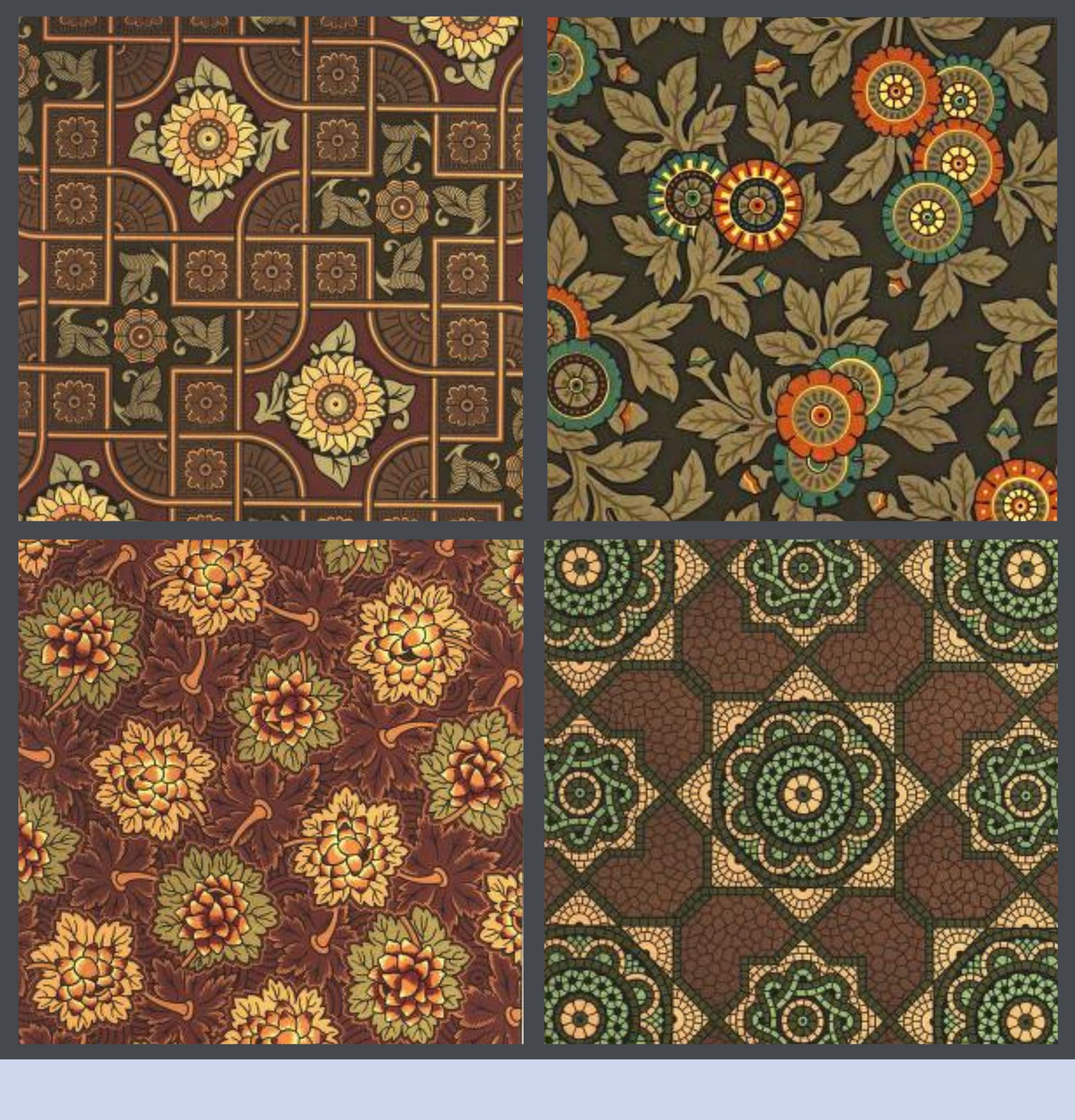 She trots along, showing us patterns made through the 1950’s. Many of them are incredible pieces of art. At one point, she entreats us to write the manufacturers of resilient flooring letting them know that if they were to make these patterns, we would buy them, & she includes their contact information. I wouldn’t mind seeing someone organize a demonstration. While my knees wouldn’t allow me to participate, I’d be more than glad to create press releases & kick in some funding for bottled water for the picketers.
She trots along, showing us patterns made through the 1950’s. Many of them are incredible pieces of art. At one point, she entreats us to write the manufacturers of resilient flooring letting them know that if they were to make these patterns, we would buy them, & she includes their contact information. I wouldn’t mind seeing someone organize a demonstration. While my knees wouldn’t allow me to participate, I’d be more than glad to create press releases & kick in some funding for bottled water for the picketers.
You can read about another solution here.
CARE AND REPAIR OF LINOLEUM
Linoleum deteriorates from use & neglect. It just does. Jane teaches us how to clean them & teaches us how to roll a lino rug.
PATTERNS
There’s not a great deal to know about this material, but I do not mind at all seeing all the designs. She also shows us some very cool vintage lino ads, which I love because they place the materials within the context of the time period.
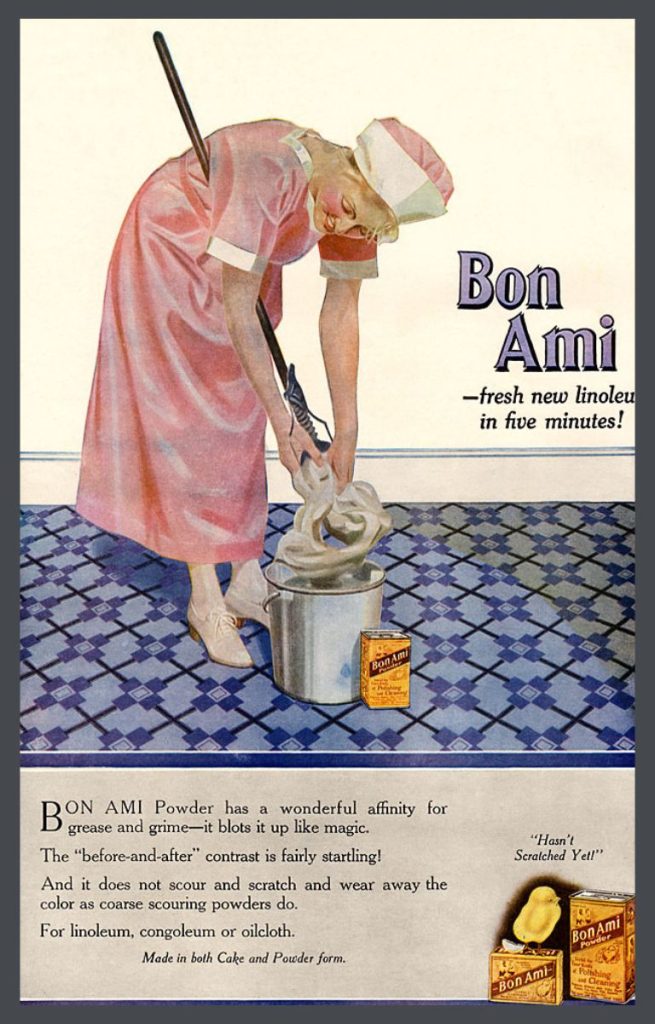
The ones made for the nursery are precious with story characters, bunnies, kitties & lambies. Yep, you’ll need to get ahold of the book to see those.
URINE THE MONEY- AN ELEGANT CHAPTER OF JANE POWELL’S BOOK, LINOLEUM
Like Jane, my kitties are my babies & I love her, (You can read our story here.) so I forgive her for the chapter (& its not so lovely name) about pet pee.
After my first perusal of LINOLEUM by Jane Powell almost 20 years ago, I shed a few tears for these wonderful lino patterns that are now extinct. (Sniff. Sniff.) Howevah, I painted a lino floor in the 80’s with great success & I did some research to see if I what I did was brilliant or just dang lucky. Here’s what I discovered about how to paint a lino floor.
Jane’s book on kitchens features some great lino floors & placing them in context makes the material even more appealing. This group of curated videos about lino will amuse you too.
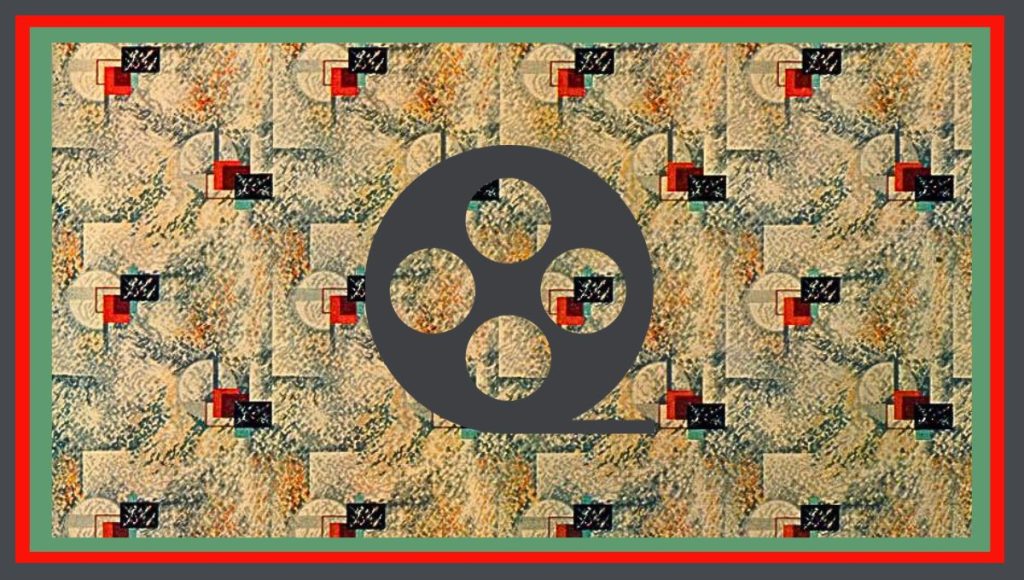
READ ALL JANE’S BOOKS ABOUT BUNGALOWS!
 BUNGALOW BATHROOMS
BUNGALOW BATHROOMS
Everything you need to know to restore or create a beautiful & functional bungalow bathroom.
 BUNGALOW DETAILS: EXTERIOR
BUNGALOW DETAILS: EXTERIOR
What makes a bungalow.
 BUNGALOW DETAILS: INTERIOR
BUNGALOW DETAILS: INTERIOR
Your inspiration for a beautiful home.
 BUNGALOW: THE ULTIMATE ARTS & CRAFTS HOME
BUNGALOW: THE ULTIMATE ARTS & CRAFTS HOME
All things bungalow.

STAY IN THE BUNGALOW KNOW!!!
Sign up for our newsletter & receive our FREE E-book, 7 VITAL Things to Do Before You Hire a Contractor.
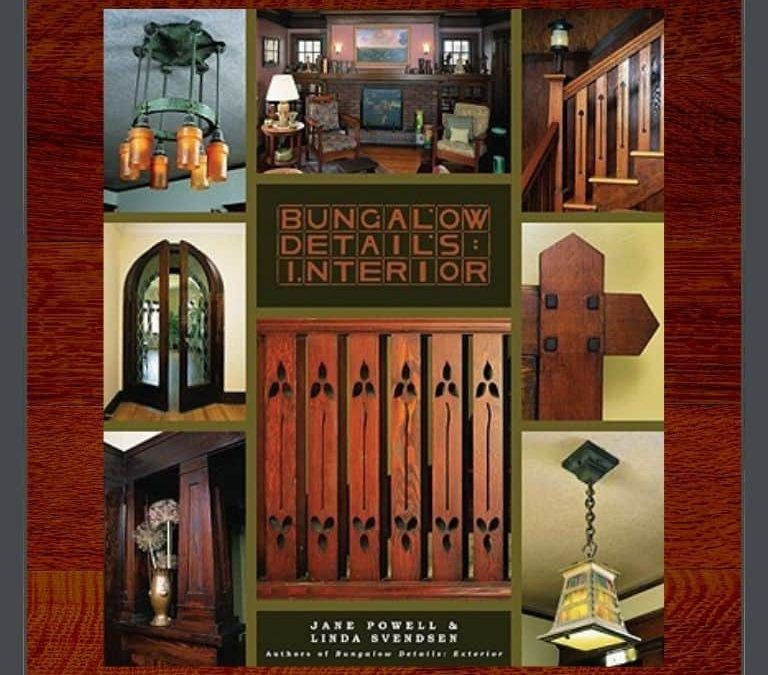
by bungalow101 | Jun 19, 2022 | Other areas
by Jane Powell, author & Linda Svendsen, photographer
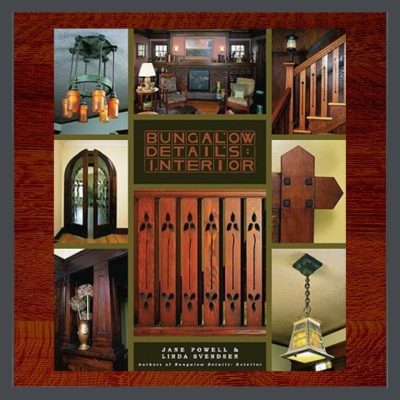 In BUNGALOW DETAILS: INTERIOR, author Jane Powell covers every nook & cranny of America’s favorite house.
In BUNGALOW DETAILS: INTERIOR, author Jane Powell covers every nook & cranny of America’s favorite house.
FOREWARD
“It is the great excellence of a writer to put into his book as much as his book will hold.” – Samuel Johnson
Written 2 years after BUNGALOW: The Ultimate Arts & Crafts Home, this book, though less chunky is still described by Jane as “the longest I have ever written.” The book is crammed with information & text is tiny, but I still recommend giving it a good read. You can rest your eyes by looking at the soothing pictures & occasionally taking a ginger tea break. But, I assure you that after absorbing the contents of this book, you will be an expert, an authority, verily a master on the subject & will be able to amaze your friends with your knowledge. It will also teach you how to live in a bungalow.
As in KITCHENS & BATHROOMS, in every restoration facet she offers compromise solutions.
And, back to the book contents, Jane devotes a whole page to asbestos & strongly recommends testing. I second. Restoring old houses is not for sissies.
CHAPTER ONE: WHAT IS A BUNGALOW?
Here she defines is as a “Know one when you see one kind of things,” but goes on to define it as:
A bungalow is a one-or one-&-a-half story house of simple design& expressed structure, built from local or natural materials, with a low sloping roof, overhanging eaves, & a prominent porch, built during the Arts & Crafts period in America (approximately 1900-1930). But offers the disclaimer, that the definition is pretty broad & you just need to look at enough of them until you know.
Should you be desperate to know now, a check out preservation expert Jo-Anne Peck’s article WHAT THE HECK IS A BUNGALOW, ANYWAY, here.
CHAPTER TWO: ROOM TO MOVE
Here she discusses layout & tours us through the rooms of several bungalows, allowing us to see some classic bungalow features in several homes.
CHAPTER THREE: SHORT STORY
Yeah, it’s a pun. Jane’s talking about roofs & attics here including pests found in them. She also discusses insulation (or the lack thereof) & ventilation.
CHAPTER FOUR: CEILING GROOVY
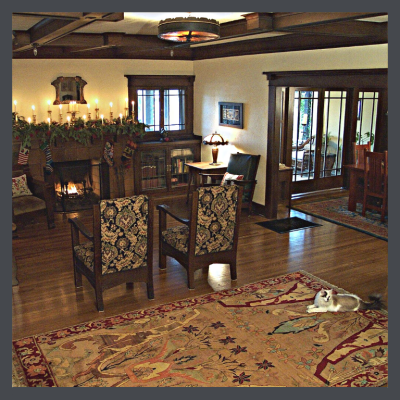 You can’t see me. I am shaking my head. But I am somewhat (It’s a very small picture.) calmed by the image I see of the beautiful box beam ceilings in the living room of the Hare House, my 1920 Craftsman in L.A., on page 56.
You can’t see me. I am shaking my head. But I am somewhat (It’s a very small picture.) calmed by the image I see of the beautiful box beam ceilings in the living room of the Hare House, my 1920 Craftsman in L.A., on page 56.
Jane describes ceiling cracks, their causes & not surprisingly, recommends against covering them with gold-veined mirror tiles. My ceilings in the Hare House were coated with “popcorn.” Yes, even between the box beams in this room & in every other room in the house. It wasn’t terribly difficult to remove, in fact, after we had sprayed a chunky section of the back bedroom ceiling, the whole thing fell down. Whumph! The sound & the dust were like a nuclear explosion. All the popcorn, all the plaster, down to the lathe, it was on the floor in one piece. A cracked piece, for sure, but it was all there. Amazingly, nobody was standing under it.
She devotes a whole page to asbestos & strongly recommends testing. I second.
CHAPTER FIVE: WALL MART
Whoo, boy! This is a chunky chapter so I think I’ll just list what is covered in it, with little commentary.
- Joinery & nails
- Balloon framing
- Brick & stone
- Paint types & colors
- Stencils
- Wallpaper
- Paneling & trim
- Built-ins
- Wood stains & finishes
As always, the book is well-illustrated with beautiful examples of every topic & sub-topic. And, she ends with her sensible obsessive & compromise solutions
CHAPTER SIX: OPENING LINES
The chapter opens with Jane saying, “Bungalow designers did their best to open the houses to the outdoors with generous numbers of windows & doors. The interplay between indoors & out made even a small bungalow larger than it really was. There was also a belief that fresh air & sunshine would kill germs, prevent disease & promote good health.”
She gives us a brief window history lesson, including some information about glass.
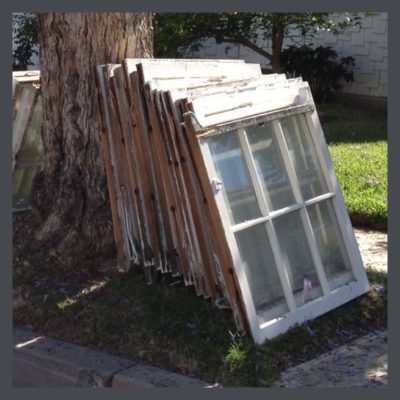 The best part is her dissertation on why replacing wood windows is a travesty. She lays out 4 pages, in tiny type, enumerating all the lie$ that are told to encourage people to rip out their wonderful old windows & install, new, hideous ones that you can replace in 15 years when they fail because they cannot be repaired. In her OBSESSIVE/COMPROMISE section, she says that she refuses to compromise.
The best part is her dissertation on why replacing wood windows is a travesty. She lays out 4 pages, in tiny type, enumerating all the lie$ that are told to encourage people to rip out their wonderful old windows & install, new, hideous ones that you can replace in 15 years when they fail because they cannot be repaired. In her OBSESSIVE/COMPROMISE section, she says that she refuses to compromise.
As I sit here writing, tears are dripping down my face, missing this funny, fierce woman. I have written so much about her, but it is in this section that her firey spirit truly shines. I can only pray that my little blog will help her message live on.
A blow & a sniff later & I’m ready to carry on. She gives complete instructions for repairing a wood window, suggesting tools & materials. Then she treats us to vintage ad images for windows parts & signs off with a section on window treatments.
I offer window suggestions in my own article, here.
CHAPTER SEVEN: ENTRY LEVEL
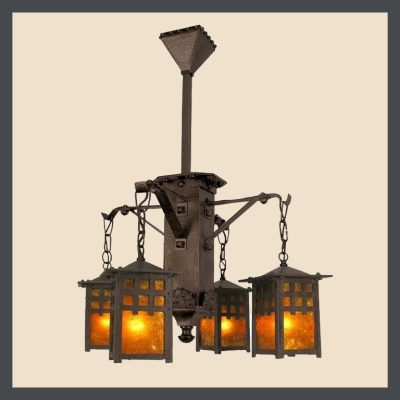 Not surprisingly, this chapter is about doors, types of doors, (interior & exterior) door construction, & door hardware-with the same great photos of beautiful door pulls & knobs & escutcheons. She has a number of cool, vintage ads, including one “For homes of refinement.”
Not surprisingly, this chapter is about doors, types of doors, (interior & exterior) door construction, & door hardware-with the same great photos of beautiful door pulls & knobs & escutcheons. She has a number of cool, vintage ads, including one “For homes of refinement.”
As she says, “The front door was meant to impress,” I have been impressed by more than one front door. I have to admit that the door of the Hare House is my all-time favorite & I was very torn by my choice to build a screen door so that my children could look out onto the world but be protected. (Between the skunks & coyotes, Eagle Rock was not a safe place for kitties.) We found the most figured pieces of quartersaw oak that you could imagine & with my copper screening & pegged joints, I was happy!
She also devotes several pages to lighting, treating us to some terrific examples of Arts & Crafts pendants & sconces.
In her section, CAN DON’T, she is adamant about the inappropriateness of can lighting. Once again, I concur, especially because the lighting of the time is so charming!!
I hope that this wonderful image will help you recover from the last one of the windows, abandoned, like poor relations, under the tree.
CHAPTER EIGHT: HEARTH OF THE MATTER
According to Jane, “Fire fulfills a deep & primal role in the human psyche…” Why else would there be 110 videos on YouTube of crackling fireplaces?
Anyway, we see some amazing fireplaces here- clinker brick, 2-tone brick, river-roof, cast concrete, granite & Grueby & Batchelder tiles. Not surprisingly she spends 14 pages delving into the history & construction of the fireplace.
Next is the subject of built-ins & once more, we are treated to beautiful images of sideboards, nooks, Murphy beds & stairways, plus vintage hardware ads & illustrations.
CHAPTER NINE: SUPPORT GROUP
Jane wraps it up with a discussion of floors, subfloors & joists as well as rugs & vacuum cleaners to keep all the dirt sucked up. She talks about furnaces & heating systems & we see some ads for new fangled contraptions that will keep you toasty. She shows us some really cool old water heaters & waxes enthusiastic about fuse boxes & electrical receptacles.
Last Call is about telephones with her closing statement being, “Besides, a bungalow is the best house in the world.”
READ ALL JANE’S BOOKS ABOUT BUNGALOWS!
 BUNGALOW KITCHENS
BUNGALOW KITCHENS
Restoring the heart of the home.
 BUNGALOW BATHROOMS
BUNGALOW BATHROOMS
Everything you need to know to restore or create a beautiful & functional bungalow bathroom.
 BUNGALOW DETAILS: EXTERIOR
BUNGALOW DETAILS: EXTERIOR
What makes a bungalow.
 BUNGALOW: THE ULTIMATE ARTS & CRAFTS HOME
BUNGALOW: THE ULTIMATE ARTS & CRAFTS HOME
All things bungalow.
& last but not least
 LINOLEUM
LINOLEUM
It’s not vinyl!

STAY IN THE BUNGALOW KNOW!!!
Sign up for our newsletter & receive our FREE E-book, 7 VITAL Things to Do Before You Hire a Contractor.

 The finish is the material that goes on top of a prepared wood floor- a correctly & thoroughly prepared floor- that makes it look fresh, emphasizes the grain & protects the wood, a comparatively soft & porous material.
The finish is the material that goes on top of a prepared wood floor- a correctly & thoroughly prepared floor- that makes it look fresh, emphasizes the grain & protects the wood, a comparatively soft & porous material. do not like speaking ill of members of my trade, but I have seen some pretty angry homeowners complaining about the odd choices made, resulting in high-gloss floors that gleamed like beacons in the night, floors that peeled before they were even dry & floors with their beautiful grain obscured by too many coats applied by the overzealous finisher.
do not like speaking ill of members of my trade, but I have seen some pretty angry homeowners complaining about the odd choices made, resulting in high-gloss floors that gleamed like beacons in the night, floors that peeled before they were even dry & floors with their beautiful grain obscured by too many coats applied by the overzealous finisher. Pros: Approximates the illusion of depth that old finishes- shellac, wax, & varnishes showed & it ambers over time, again mimicking those historic materials. Costs less than many other types of finishes.
Pros: Approximates the illusion of depth that old finishes- shellac, wax, & varnishes showed & it ambers over time, again mimicking those historic materials. Costs less than many other types of finishes. Pros: Easy application & cleanup; low odor and low VOCs; several gloss options, including an easy-to-use matte; no yellowing over time. Good scuff, scratch and chemical resistance at full cure. Quick drying. Easy care.
Pros: Easy application & cleanup; low odor and low VOCs; several gloss options, including an easy-to-use matte; no yellowing over time. Good scuff, scratch and chemical resistance at full cure. Quick drying. Easy care. While other finish systems sit on top of the surface of the wood, oil penetrating wood finishes go down into the fibers of the wood, then harden on the surface.
While other finish systems sit on top of the surface of the wood, oil penetrating wood finishes go down into the fibers of the wood, then harden on the surface. STAY IN THE BUNGALOW KNOW!!!
STAY IN THE BUNGALOW KNOW!!!


 I consider historic bungalow wood floors to be the single most endangered historic fabric, well, maybe second to windows! As a tree-hugging, wood flooring professional, specializing in the restoration & preservation of historic floors, I’d like to pass on what I have learned in over 40 years in the trade. I’m starting here with HISTORIC BUNGALOW WOOD FLOORS 101- From the Forest to Your Floor, so that you will understand the value of your original wood flooring material that was gifted to us by the forest primeval.
I consider historic bungalow wood floors to be the single most endangered historic fabric, well, maybe second to windows! As a tree-hugging, wood flooring professional, specializing in the restoration & preservation of historic floors, I’d like to pass on what I have learned in over 40 years in the trade. I’m starting here with HISTORIC BUNGALOW WOOD FLOORS 101- From the Forest to Your Floor, so that you will understand the value of your original wood flooring material that was gifted to us by the forest primeval. Your historic bungalow’s wood floor began as trees. It is a product of Mother Nature, gifted by her warmth & beauty, but also subject to her whims. Consequently, to fully understand & properly care for your floor, it helps to know a bit about your floor’s life from its conception.
Your historic bungalow’s wood floor began as trees. It is a product of Mother Nature, gifted by her warmth & beauty, but also subject to her whims. Consequently, to fully understand & properly care for your floor, it helps to know a bit about your floor’s life from its conception. The bark covers the tree to protect it from pests & disease. Just under the bark is the layer called the cambium. It is made of growth tissue cells & these cells divide to increase the tree’s diameter.
The bark covers the tree to protect it from pests & disease. Just under the bark is the layer called the cambium. It is made of growth tissue cells & these cells divide to increase the tree’s diameter.

 There are several species of wood flooring most commonly found in historic bungalows. I have seen others but the species below are the ones to consider first when you do not know what your floor is.
There are several species of wood flooring most commonly found in historic bungalows. I have seen others but the species below are the ones to consider first when you do not know what your floor is. White Oak (Quercus alba)
White Oak (Quercus alba) Red Oak (Quercus rubra)
Red Oak (Quercus rubra) Maple (Acer saccharum)
Maple (Acer saccharum) Mahogany (Swietenia macrophylla)
Mahogany (Swietenia macrophylla) Douglas Fir (Pseudotsuga menziesii)
Douglas Fir (Pseudotsuga menziesii) Heart Pine (Pinus palustris)
Heart Pine (Pinus palustris)






















 Many people consider LINOLEUM by Jane Powell to be their favorite book in the series. There are others who don’t get this beautiful, functional material & consider it to be a cheap, substandard product. Nope!
Many people consider LINOLEUM by Jane Powell to be their favorite book in the series. There are others who don’t get this beautiful, functional material & consider it to be a cheap, substandard product. Nope! Let’s look at vinyl from an Arts & Crafts viewpoint, shall we? My BFF here is William Morris, the founder of the Arts & Crafts Movement in England who asserts, “If you cannot learn to love real flooring, at least learn to hate sham flooring & reject it.”
Let’s look at vinyl from an Arts & Crafts viewpoint, shall we? My BFF here is William Morris, the founder of the Arts & Crafts Movement in England who asserts, “If you cannot learn to love real flooring, at least learn to hate sham flooring & reject it.” She trots along, showing us patterns made through the 1950’s. Many of them are incredible pieces of art. At one point, she entreats us to write the manufacturers of resilient flooring letting them know that if they were to make these patterns, we would buy them, & she includes their contact information. I wouldn’t mind seeing someone organize a demonstration. While my knees wouldn’t allow me to participate, I’d be more than glad to create press releases & kick in some funding for bottled water for the picketers.
She trots along, showing us patterns made through the 1950’s. Many of them are incredible pieces of art. At one point, she entreats us to write the manufacturers of resilient flooring letting them know that if they were to make these patterns, we would buy them, & she includes their contact information. I wouldn’t mind seeing someone organize a demonstration. While my knees wouldn’t allow me to participate, I’d be more than glad to create press releases & kick in some funding for bottled water for the picketers.


 In BUNGALOW
In BUNGALOW You can’t see me. I am shaking my head. But I am somewhat (It’s a very small picture.) calmed by the image I see of the beautiful box beam ceilings in the living room of the
You can’t see me. I am shaking my head. But I am somewhat (It’s a very small picture.) calmed by the image I see of the beautiful box beam ceilings in the living room of the  The best part is her dissertation on why replacing wood windows is a travesty. She lays out 4 pages, in tiny type, enumerating all the lie$ that are told to encourage people to rip out their wonderful old windows & install, new, hideous ones that you can replace in 15 years when they fail because they cannot be repaired. In her OBSESSIVE/COMPROMISE section, she says that she refuses to compromise.
The best part is her dissertation on why replacing wood windows is a travesty. She lays out 4 pages, in tiny type, enumerating all the lie$ that are told to encourage people to rip out their wonderful old windows & install, new, hideous ones that you can replace in 15 years when they fail because they cannot be repaired. In her OBSESSIVE/COMPROMISE section, she says that she refuses to compromise. Not surprisingly, this chapter is about doors, types of doors, (interior & exterior) door construction, & door hardware-with the same great photos of beautiful door pulls & knobs & escutcheons. She has a number of cool, vintage ads, including one “For homes of refinement.”
Not surprisingly, this chapter is about doors, types of doors, (interior & exterior) door construction, & door hardware-with the same great photos of beautiful door pulls & knobs & escutcheons. She has a number of cool, vintage ads, including one “For homes of refinement.”